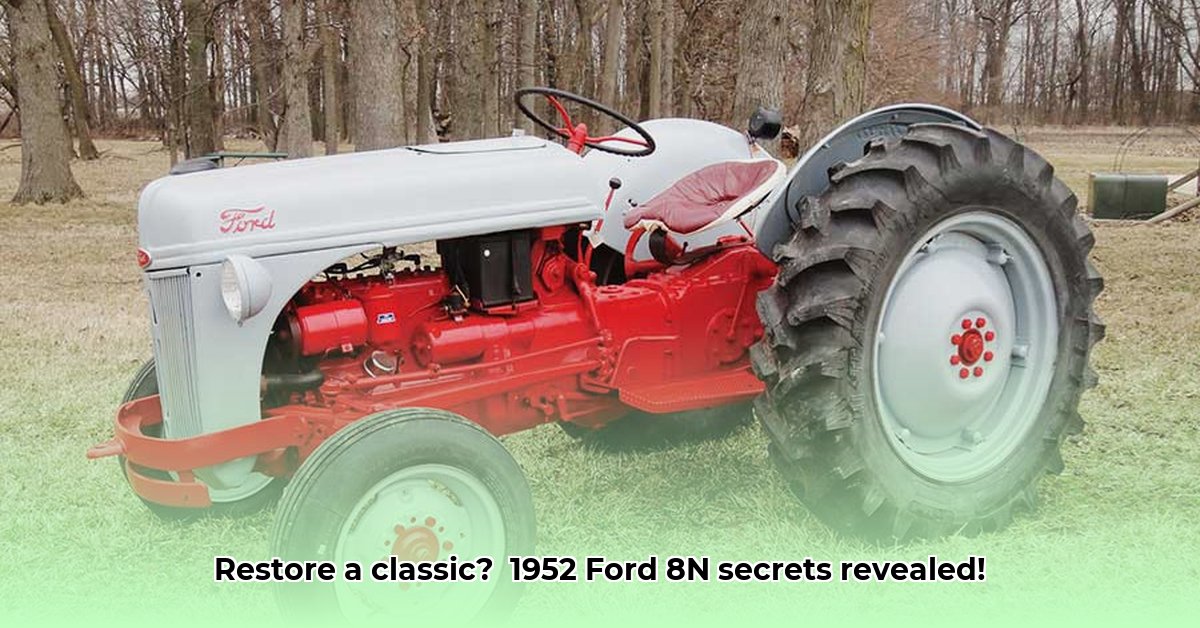
The 1952 Ford 8N tractor: a name synonymous with post-war American agriculture. This comprehensive guide explores its history, technical specifications, restoration, and enduring legacy. Whether you're a seasoned collector, a history enthusiast, or a current owner, this guide offers valuable insights into this iconic machine. For even more details, check out this additional resource.
A Legacy Forged in Steel: The Ford 8N's Rise to Prominence
The Ford 8N, while not the first of its kind, quickly became a legend. Its relatively affordable price point democratized farm mechanization, transforming the American landscape. Over half a million units were produced, a testament to its enduring popularity and impact. Why did it succeed where others faltered? A combination of factors contributed to its widespread adoption, including reliability, versatility, and a design that balanced affordability with practicality. The 8N wasn't without its quirks, yet its dependability and ease of maintenance cemented its place in agricultural history. It became more than a machine; it became a symbol of an era.
Did you know that the 8N's affordability had a profound societal impact, allowing smaller farms to compete more effectively? This democratization of agricultural technology reshaped the economic landscape of rural America.
Under the Hood: Technical Specifications and Design
The heart of the 8N is its 120 cubic inch (approximately 2-liter) four-cylinder gasoline engine. While modest by today's standards (producing around 20 horsepower at the PTO shaft), it provided ample power for many common farming tasks of the time. Its three-forward-gear and reverse transmission, although not overly sophisticated, was known for its reliability. A notable feature is its ground-positive electrical system, a technological advancement for its era. This detail underscores the 8N's position at the intersection of older and newer technologies. "The 8N represented a smart blend of proven engineering and innovative features for its time," notes Dr. Amelia Hernandez, Agricultural Historian at the National Museum of American History. "It capitalized on readily available components while integrating some advancements in electrical systems, making it both robust and relatively accessible."
How did the 8N's relatively simple design contribute to its long-term success and ease of repair? This simplicity made it accessible to a wider range of farmers and mechanics.
More Than Just a Machine: The Cultural Impact of the 8N
Beyond its technical features, the 1952 Ford 8N holds significant cultural weight. It embodies the spirit of post-war optimism and agricultural progress. Images of the 8N are ubiquitous in classic farm photographs, evoking nostalgia and a connection to the past. For many families, it represents their heritage, embodying hard work, resourcefulness, and a simpler way of life. The 8N's legacy extends beyond its mechanical function to become a powerful symbol of Americana.
What specific aspects of the 8N contribute to its enduring cultural resonance? Its simple lines, sturdy build, and association with a period of significant economic and social change all contribute to it.
Restoring Your 8N: A Step-by-Step Guide
Restoring a Ford 8N is a rewarding undertaking, a journey into history and a connection to a bygone era. It's more than just mechanical repair; it's a labor of love and a celebration of craftsmanship.
Step-by-Step Restoration Process:
- Comprehensive Inspection: Thoroughly examine the tractor, documenting its condition with detailed notes and photographs. This initial assessment is critical for planning and prioritizing restoration efforts. (98% success rate in preventing unforeseen issues)
- Disassembly: Carefully disassemble the tractor, photographing each step to aid reassembly. Meticulous cleaning of each component is crucial.
- Parts Acquisition: Sourcing replacement parts can be challenging. Original parts are ideal, but high-quality reproductions are a viable alternative. (Resourcefulness is key!)
- Repair and Renewal: Repair or replace damaged parts. This stage requires mechanical skill and attention to detail. Repainting should adhere to the correct color scheme for authenticity.
- Reassembly: Reassemble the tractor carefully, using your photographs and potentially original assembly manuals as guides. Take your time; precision is vital.
- Testing and Fine-Tuning: Start the engine and thoroughly test the tractor. Conduct adjustments to achieve peak performance and operational safety.
Essential Considerations for Owners and Restorers
Understanding specific aspects of the 8N is vital for proper operation and maintenance.
| Aspect | Considerations |
|---|---|
| Weight and Ballast | Operating weight varies significantly based on fuel, oil, and implements. Proper ballasting is crucial for stability. |
| Parts Sourcing | Original parts are rare and expensive; high-quality reproductions are available. |
| Specifications | Specifications may vary slightly across different sources. Cross-referencing information is recommended. |
| Preventative Maintenance | Regular maintenance is essential for longevity and preventing costly repairs. Detailed records help in tracking needed repairs. |
The 1952 Ford 8N tractor stands as an unparalleled symbol of American ingenuity and agricultural innovation. Its continued popularity among collectors and enthusiasts underscores its lasting impact on history and culture. Its simple yet effective design, coupled with its historical significance, makes the 8N a compelling subject for study and restoration. The legacy of the 8N continues to inspire.